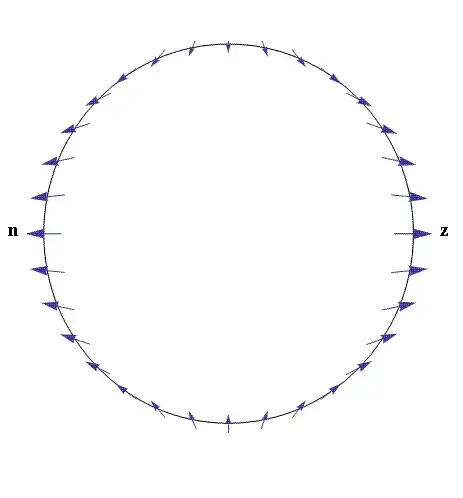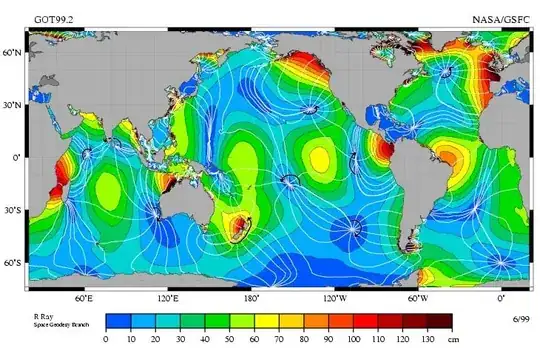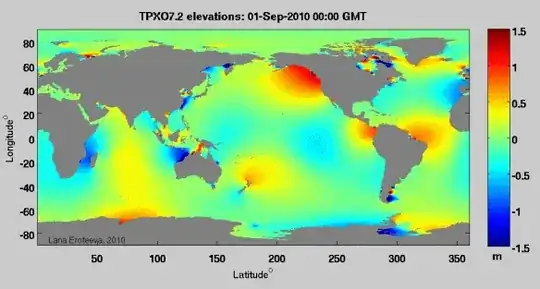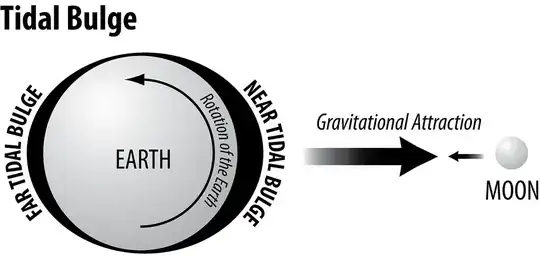There is no tidal bulge.
This was one of Newton's few mistakes. Newton did get the tidal forcing function correct, but the response to that forcing in the oceans: completely wrong.
Newton's equilibrium theory of the tides with its two tidal bulges is falsified by observation. If this hypothesis was correct, high tide would occur when the Moon is at zenith and at nadir. Most places on the Earth's oceans do have a high tide every 12.421 hours, but whether those high tides occur at zenith and nadir is sheer luck. In most places, there's a predictable offset from the Moon's zenith/nadir and the time of high tide, and that offset is not zero.
One of the most confounding places with regard to the tides is Newton's back yard. If Newton's equilibrium theory was correct, high tide would occur at more or less the same time across the North Sea. That is not what is observed. At any time of day, one can always find a place in the North Sea that is experiencing high tide, and another that is simultaneously experiencing low tide.
Why isn't there a bulge?
Beyond the evidence, there are a number of reasons a tidal bulge cannot exist in the oceans.
The tidal bulge cannot exist because the way water waves propagate. If the tidal bulge did exist, it would form a wave with a wavelength of half the Earth's circumference. That wavelength is much greater than the depth of the ocean, which means the wave would be a shallow wave. The speed of a shallow wave at some location is approximately $\sqrt{gd}$, where $d$ is the depth of the ocean at that location. This tidal wave could only move at 330 m/s over even the deepest oceanic trench, 205 m/s over the mean depth of 4267 m, and less than that in shallow waters. Compare with the 465 m/s rotational velocity at the equator. The shallow tidal wave cannot keep up with the Earth's rotation.
The tidal bulge cannot exist because the Earth isn't completely covered by water. There are two huge north-south barriers to Newton's tidal bulge, the Americas in the western hemisphere and Afro-Eurasia in the eastern hemisphere. The tides on the Panama's Pacific coast are very, very different from the tides just 100 kilometers away on Panama's Caribbean coast.
A third reason the tidal bulge cannot exist is the Coriolis effect. That the Earth is rotating at a rate different from the Moon's orbital rate means that the Coriolis effect would act to sheer the tidal wave apart even if the Earth was completely covered by a very deep ocean.
What is the right model?
What Newton got wrong, Laplace got right.
Laplace's dynamic theory of the tides accounts for the problems mentioned above. It explains why it's always high tide somewhere in the North Sea (and Patagonia, and the coast of New Zealand, and a few other places on the Earth where tides are just completely whacko). The tidal forcing functions combined with oceanic basin depths and outlines results in amphidromic systems. There are points on the surface, "amphidromic points", that experience no tides, at least with respect to one of the many forcing functions of the tides. The tidal responses rotate about these amphidromic points.
There are a large number of frequency responses to the overall tidal forcing functions. The Moon is the dominant force with regard to the tides. It helps to look at things from the perspective of the frequency domain. From this perspective, the dominant frequency on most places on the Earth is 1 cycle per 12.421 hours, the M2 tidal frequency. The second largest is the 1 cycle per 12 hours due to the Sun, the S2 tidal frequency. Since the forcing function is not quite symmetric, there are also 1 cycle per 24.841 hours responses (the M1 tidal frequency), 1 cycle per 24 hours responses (the S1 tidal frequency), and a slew of others. Each of these has its own amphidromic system.
With regard to the North Sea, there are three M2 tidal amphidromic points in the neighborhood of the North Sea. This nicely explains why the tides are so very goofy in the North Sea.
Images
For those who like imagery, here are a few key images. I'm hoping that the owners of these images won't rearrange their websites.
The tidal force

Source: https://physics.mercer.edu/hpage/tidal%20asymmetry/asymmetry.html
This is what Newton did get right. The tidal force is away from the center of the Earth when the Moon (or Sun) is at zenith or nadir, inward when the Moon (or Sun) is on the horizon. The vertical component is the driving force behind the response of the Earth as a whole to these tidal forces. This question isn't about the Earth tides. The question is about the oceanic tides, and there it's the horizontal component that is the driving force.
The global M2 tidal response

Source: https://en.wikipedia.org/wiki/File:M2_tidal_constituent.jpg

Source: http://volkov.oce.orst.edu/tides/global.html[broken link, not archived]
The M2 constituent of the tides is the roughly twice per day response to the tidal forcing function that results from the Moon. This is the dominant component of the tides in many parts of the world. The first image shows the M2 amphidromic points, points where there is no M2 component of the tides. Even though these points have zero response to this component, these amphidromic points are nonetheless critical in modeling the tidal response. The second image, an animated gif, shows the response over time.
The M2 tidal response in the North Sea

Archived source: www.geog.ucsb.edu/~dylan/ocean.html
I mentioned the North Sea multiple times in my response. The North Atlantic is where 40% of the M2 tidal dissipation occurs, and the North Sea is the hub of this dissipation.
Energy flow of the semi-diurnal, lunar tidal wave (M2)

Archived source: www.altimetry.info/thematic-use-cases/ocean-applications/tides/ (www.altimetry.info/wp-content/uploads/2015/06/flux_energie.gif)
The above image displays transfer of energy from places where tidal energy is created to places where it is dissipated. This energy transfer explains the weird tides in Patagonia, one of the places on the Earth where tides are highest and most counterintuitive. Those Patagonian tides are largely a result of energy transfer from the Pacific to the Atlantic. It also shows the huge transfer of energy to the North Atlantic, which is where 40% of the M2 tidal dissipation occurs.
Note that this energy transfer is generally eastward. You can think of this as a representing "net tidal bulge." Or not. I prefer "or not."
Extended discussions based on comments
(... because we delete comments here)
Isn't a Tsunami a shallow water wave as well as compared to the ocean basins? I know the wavelength is smaller but it is still a shallow water wave and hence would propagate at the same speed. Why don't they suffer from what you mentioned regarding the rotational velocity of the earth.
Firstly, there's a big difference between a tsunami and the tides. A tsunami is the the result of a non-linear damped harmonic oscillator (the Earth's oceans) to an impulse (an earthquake). The tides are the response to a cyclical driving force. That said,
- As is the case with any harmonic oscillator, the impulse response is informative of the response to a cyclical driving force.
- Tsunamis are subject to the Coriolis effect. The effect is small, but present. The reason it is small is because tsunami are, for the most part, short term events relative to the Earth's rotation rate. The Coriolis effect becomes apparent in the long-term response of the oceans to a tsunami. Topography is much more important for a tsunami.
The link that follows provides an animation of the 2004 Indonesian earthquake tsunami.
References for the above:
Dao, M. H., & Tkalich, P. (2007). Tsunami propagation modelling? a sensitivity study. Natural Hazards and Earth System Science, 7(6), 741-754.
Eze, C. L., Uko, D. E., Gobo, A. E., Sigalo, F. B., & Israel-Cookey, C. (2009). Mathematical Modelling of Tsunami Propagation. Journal of Applied Sciences and Environmental Management, 13(3).
Kowalik, Z., Knight, W., Logan, T., & Whitmore, P. (2005). Numerical modeling of the global tsunami: Indonesian tsunami of 26 December 2004. Science of Tsunami Hazards, 23(1), 40-56.
This is an interesting answer full of cool facts and diagrams, but I think it's a little overstated. Newton's explanation wasn't wrong, it was an approximation. He knew it was an approximation -- obviously he was aware that the earth had land as well as water, that tides were of different heights in different places, and so on. I don't think it's a coincidence that the height of the bulge in the equipotential is of very nearly the right size to explain the observed heights of the tides.
Newton's analysis was a good start. Newton certainly did describe the tidal force properly. He didn't have the mathematical tools to do any better than what he did. Fourier analysis, proper treatment of non-inertial frames, and fluid dynamics all post-date Newton by about a century.
Besides the issues cited above, Newton ignored the horizontal component of the tidal force and only looked at the vertical component. The horizontal component wouldn't be important if the Earth was tidally locked to the Moon. The dynamical theory of the tides essentially ignores the vertical component and only looks at the horizontal component. This gives a very different picture of the tides.
I'm far from alone in saying the tidal bulge doesn't exist. For example, from this lecture,[archive link] the page on dynamic tides[archive link] rhetorically asks "But how can water confined to a basin engage in wave motion at all like the “tidal bulges” that supposedly sweep around the globe as depicted in equilibrium theory?" and immediately responds (emphasis mine) "The answer is – it can’t."
In Affholder, M., & Valiron, F. (2001). Descriptive Physical Oceanography. CRC Press, the authors introduce Newton's equilibrium tide but then write (emphasis mine) "For the tidal wave to move at this enormous speed of 1600 km/h, the ideal ocean depth would have to be 22 km. Taking the average depth of the ocean as 3.9 km, the speed of the tidal elevations can only be 700 km/h. Therefore the equilibrium position at any instant required by this theory cannot be established."
Oceanographers still teach Newton's equilibrium tide theory for a number of reasons. It does give a proper picture of the tidal forcing function. Moreover, many students do not understand how many places can have two tides a day. For that matter, most oceanography instructors and textbook authors don't understand! Many oceanographers and their texts still hold that the inner bulge is a consequence of gravity but the other bulge is a consequence of a so-called centrifugal force. This drives geophysicists and geodocists absolutely nuts. That's starting to change; in the last ten years or so, some oceanography texts have finally started teaching that the only force that is needed to explain the tides is gravitation.








